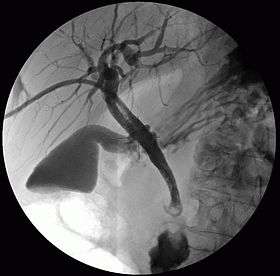Percutaneous transhepatic cholangiography
| Percutaneous transhepatic cholangiography | |
|---|---|
| Intervention | |
 Percutaneous transhepatic cholangiography | |
| ICD-9-CM | 87.51 |
| OPS-301 code | 3-13c.1 |
Percutaneous transhepatic cholangiography (PTHC or PTC) or percutaneous hepatic cholangiogram is a radiologic technique used to visualize the anatomy of the biliary tract. A contrast medium is injected into a bile duct in the liver, after which X-rays are taken. It allows access to the biliary tree in cases where endoscopic retrograde cholangiopancreatography (ERCP) has been unsuccessful. Initially reported in 1937, the procedure became popular in 1952.[1][2]
It is predominantly now performed as a therapeutic technique. There are less invasive means of imaging the biliary tree including transabdominal ultrasound, magnetic resonance cholangiopancreatography, computed tomography and endoscopic ultrasound. If the biliary system is obstructed, PTC may be used to perform biliary drainage until a more permanent solution for the obstruction is performed (e.g. surgery). Additionally, self expanding metal stents can be placed across malignant biliary strictures to allow palliative drainage. Percutaneous placement of metal stents can be utilised when therapeutic ERCP has been unsuccessful, anatomy is altered precluding endoscopic access to the duodenum, or where there has been separation of the segmental biliary drainage of the liver, allowing more selective placement of metal stents. It is generally accepted that percutanous biliary procedures have higher complication rates than therapeutic ERCP. Complications encountered include infection, bleeding and bile leaks.
Indications
Cholestatic jaundice, to exclude extra hepatic bile duct obstruction, prior to biliary drainage procedure.
Contraindications
- Bleeding tendency
- biliary tract sepsis
- unfit for surgery
- hydatid cysts
- ascites
- CLD (chronic liver disease)
References
- ↑ Carter RF, Saypol GM (1952). "Transabdominal cholangiography". Journal of the American Medical Association. 148 (4): 253–5. doi:10.1001/jama.1952.02930040009002. PMID 14888454.
- ↑ Atkinson M, Happey MG, Smiddy FG (1960). "Percutaneous transhepatic cholangiography". Gut. 1 (4): 357–65. doi:10.1136/gut.1.4.357. PMC 1413224
 . PMID 13684978.
. PMID 13684978.